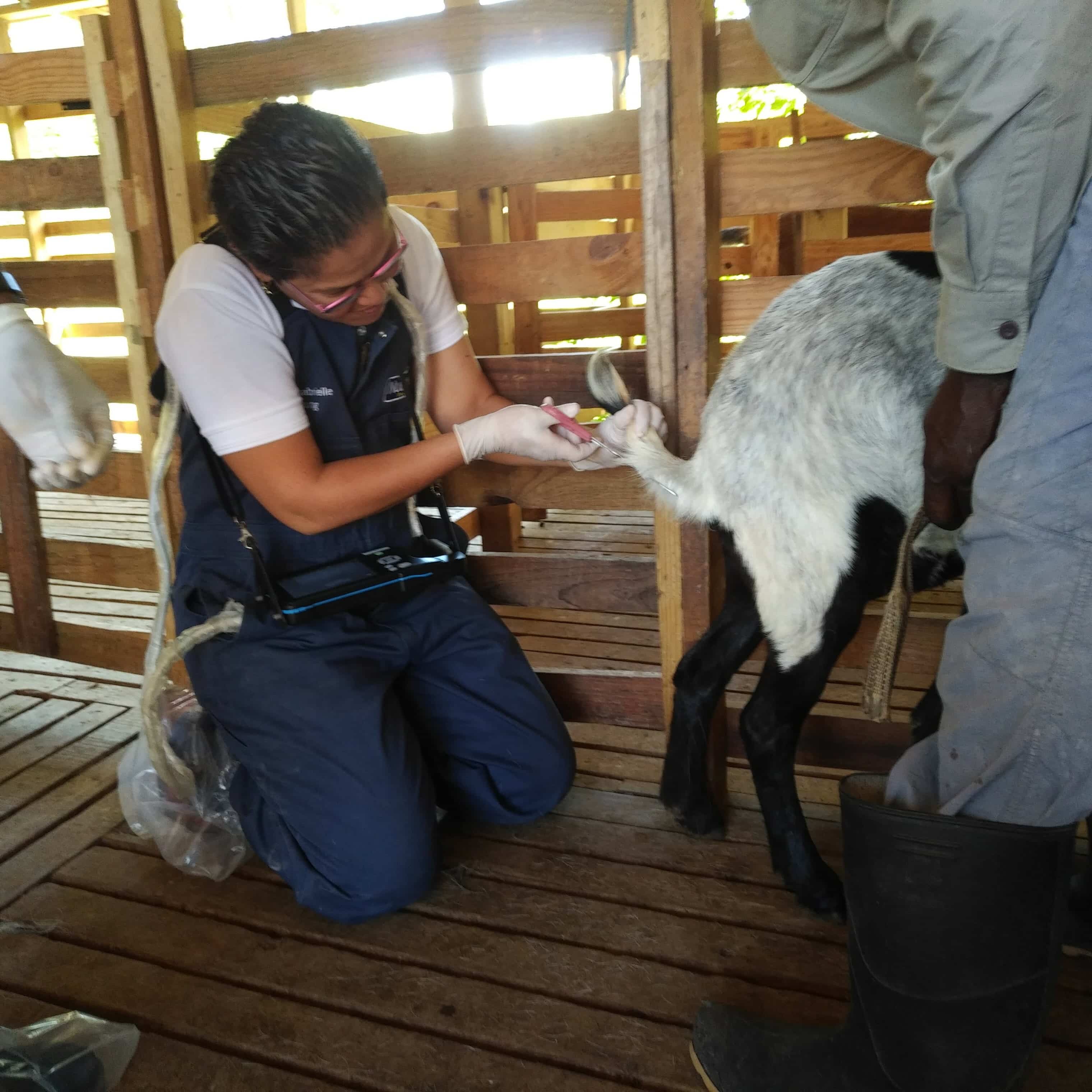We are so excited to tell you about our Semen and Embryo Transplant Project at RGD!
We have been working on the importation of semen and embryos from Canada for the past year and, at last the special shipment has arrived!
The NutraMix feed company has been invaluable with their assistance to make this happen. We’ve also had the support of the Small Ruminant Ass’n of Jamaica, Fulcrum Agricultural Consulting in Ontario and an array of interested individuals. We are grateful to all!
History:
Although there have been dairy goats in Ja for some time, there has been little active milking of goats, nor development of goats with pedigrees for significant milk capacity. For RGD, that results in many mouths to feed and limited milk from each goat.
Saanen Goats – History & Characteristics:
The semen and embryos are from Canadian Saanen goats. Yes, Canada. Canada has an agreement to export semen and embryos to Ja. Saanen goats used to be prominent in the US. But in the 1930s dairy farms were hit hard by the Depression and many closed. Saanen goat breeders then suffered and many went out of business. In the 1940s through 1960s the Saanen breed was revitalized via importation from England via Canada to the US.
The Saanen goats are white or tan. It is a breed known for its tolerance of many climates, adaptability to change and reputation as a powerhouse of milk production, disease resistance, stamina and temperament. Saanen milk is not especially known for its taste, but because the Saanen milk will be mixed with the milk from our Nubian, Alpine and local goats this is not a concern. The taste is not ‘bad’ just a bit different! Saanen milk is used around the world for goat milk products (RGD customers, don’t worry!)
Interestingly, because of the Saanen’s pale skin, availability of shade is a must. . .fortunately, our farm has some beautiful shade trees as well as the overhang of the goathouse roof!
RGD Situation:
We have needed more milk. . .many of you have been told at some point that due to limited milk we were not able to supply you with this or that. . . Also, we have ‘many mouths to feed’ but get limited milk from our goats. The expense of vaccinations, general vet care, housing, food, etc., for the goats and then the resulting limited milk production convinced us to pursue this route of improving our ‘herd.’ Our goats, both those with relatively big milk supplies and those with small will be participating in this project. Both will be the recipient of Saanen semen. The resulting babies-we hope a plethora of females – will then have the capacity for greater milk production because of their Saanen heritage. Obviously, this takes a few generations. . . .
The faster route are fertilized embryos. We will be transplanting two fertilized embryos into three of our goats. Why only three? Because of the cost of embryos vs semen. For babies born via the embryo route, the ‘returns’ will be relatively immediate. Any females born from the embryos transplanted into our goats will be 100{2dfd092df91717c26e35edf910fce9c6c3d4dd41910c3af563e7b9e97b5ba11a} Saanen and, once they become pregnant, will have much greater milk capacity when they lactate when their babies are born. Goat embryos, unlike other animals’ embryos coming into Ja are not “sexed.” So, we do not know what sex our embryos are. . .again, we hope for females!
Phase 1:
On February 7th, Dr Gabriel Young, the vet from Nutramix, assessed the chosen goats, doing an ultrasound on each to confirm none were pregnant. Then, each goat was administered a hormone vaginally– CIDR- a form of progesterone. It was step 1 of a three step hormone process to put the goats into heat so they can successfully accept the semen and embryos later this month. We chose both goats who are virgins and some with a history of successful pregnancies. We’ll post pictures and explain the subsequent phases over the next few weeks and give updates.
How You Can Help:
It is clear from the above, we need successful pregnancies and then we need females born from those pregnancies whether the origin is the embryos or the semen. The last time semen was administered in Ja the success rate was approximately 30{2dfd092df91717c26e35edf910fce9c6c3d4dd41910c3af563e7b9e97b5ba11a}. Discouraging. However, we hope for better! We have enough semen that we can repeat the process w more semen for any goats that do not become pregnant. We are also going to increase the odds by administering two doses of semen per goat rather than one. And, of course, we will continue to provide the best care possible.
If you know of any fertility prayers, poems, dances, drinks, songs, voodoo, etc-we are open!! Also, we believe in the power of ‘sending’ good thoughts and prayers.
The gestation period for goats is five months. We’ll know 4-6 weeks after the procedures on February 21st and 27th which goats are pregnant. We’ll keep you up to date. We have purchased champagne to celebrate any and all successes- pregnancies and births!
And, for those of you concerned about the possibility of many males being born of these efforts. . .well, we admit, we are too– one of our breeding seasons we had nine babies born and 8 of them were male. We hope we’ve already experienced an imbalance, and statistically can expect a better male/female mix this time. Boys born of these efforts will be valued as unique in Ja-they’ll be 100{2dfd092df91717c26e35edf910fce9c6c3d4dd41910c3af563e7b9e97b5ba11a} Saanen or, 50{2dfd092df91717c26e35edf910fce9c6c3d4dd41910c3af563e7b9e97b5ba11a} Saanen. We will protect them from curry pots and they’ll live the life of sought-after studs!
Conclusion:
We welcome your good thoughts, prayers, ideas, questions and continued support of RGD products!
We will post an update here after the next hormone administration.
Thank you for your interest in Ruby Goat Dairy!


